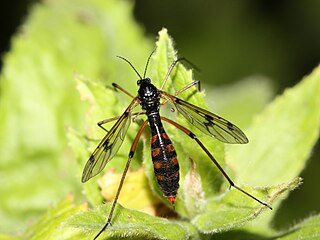
A crane fly is any member of the dipteran superfamily Tipuloidea, which contains the living families Cylindrotomidae, Limoniidae, Pediciidae and Tipulidae, as well as several extinct families. "Winter crane flies", members of the family Trichoceridae, are sufficiently different from the typical crane flies of Tipuloidea to be excluded from the superfamily Tipuloidea, and are placed as their sister group within Tipulomorpha.

The Nematocera are a suborder of elongated flies with thin, segmented antennae and mostly aquatic larvae. This group is paraphyletic and contains all flies except for species from suborder Brachycera, which includes more commonly known species such as the housefly or the common fruit fly. The equivalent clade to Nematocera is the whole Diptera, with Brachycera as a subclade. Families in Nematocera include mosquitoes, crane flies, gnats, black flies, and multiple families commonly known as midges. The Nematocera typically have fairly long, fine, finely-jointed antennae. In many species, such as most mosquitoes, the female antennae are more or less threadlike, but the males have spectacularly plumose antennae.

The Ptychopteridae, phantom crane flies, are a small family of nematocerous Diptera. Superficially similar in appearance to other "tipuloid" families, they lack the ocelli of the Trichoceridae, the five-branched radial vein of the Tanyderidae, and the two anal veins that reach the wing margins of the Tipulidae. They are usually allied with the Tanyderidae based on similarities of the mesonotal suture, this group being called the Ptychopteromorpha.

Bittacomorpha clavipes, the Eastern phantom crane fly, or Eastern North America crane fly, is a species of phantom crane fly in the family Ptychopteridae.

Bittacomorpha is a genus of phantom crane flies in the family Ptychopteridae. There are about 11 described species in Bittacomorpha.

Tipula fuliginosa, the sooty crane fly, is a species of large crane fly in the family Tipulidae. It is found in Europe.
Tipula dietziana is a species of large crane fly in the family Tipulidae.
Pedicia procteriana is a species of hairy-eyed crane fly in the family Pediciidae.
Austrolimnophila toxoneura is a species of limoniid crane fly in the family Limoniidae.
Tipula oropezoides is a species of large crane fly in the family Tipulidae.
Hadenoecus jonesi, known generally as the limrock blowing cave cricket or Jone's cave cricket, is a species of camel cricket in the family Rhaphidophoridae. It is found in North America.
Nephrotoma cingulata is a species of large crane fly in the family Tipulidae.
Tipula submaculata is a species of large crane fly in the family Tipulidae.
Nephrotoma eucera is a species of large crane fly in the family Tipulidae.
Bittacomorphella is a genus of pygmy phantom crane flies in the family Ptychopteridae. There are about 11 described species in Bittacomorphella.
Chionea albertensis is a species of limoniid crane fly in the family Limoniidae.
Neocladura delicatula is a species of limoniid crane fly in the family Limoniidae.
Tipula collaris is a species of large crane fly in the family Tipulidae.
Dolichopeza carolus is a species of large crane fly in the family Tipulidae.
Chionea valga, the snow fly, is a species of limoniid crane fly in the family Limoniidae.





